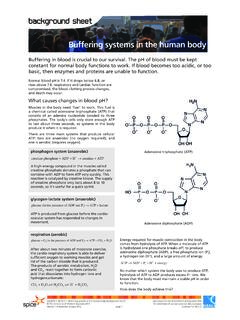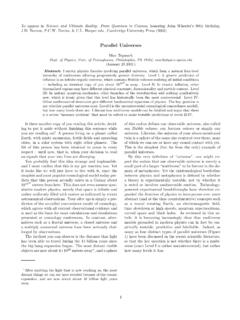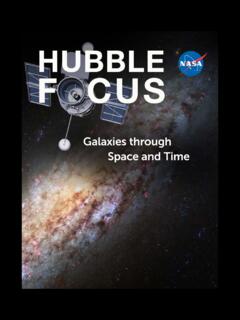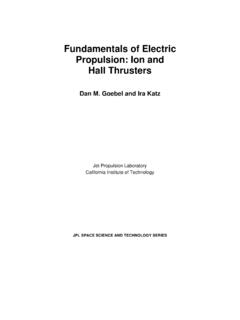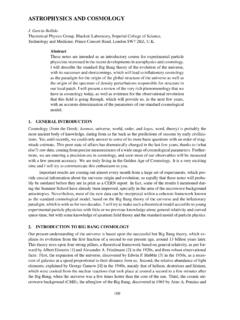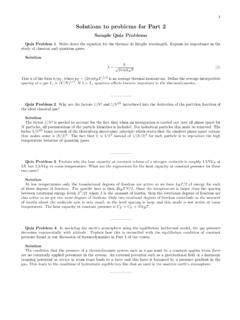Transcription of Evidence for the Big Bang - University of Western Australia
1 Fact sheet Evidence for the Big Bang What is the Big Bang theory? The Big Bang theory is an explanation of the early development of the Universe. According to this theory the Universe expanded from an extremely small, extremely hot, and extremely dense state. Since then it has expanded and become less dense and cooler. The Big Bang is the best model used by astronomers to explain the creation of matter, space and time billion years ago. What Evidence is there to support the Big Bang theory? Two major scientific discoveries provide strong support for the Big Bang theory: Hubble's discovery in the 1920s of a relationship between a galaxy's distance from Earth and its speed; and the discovery in the 1960s of cosmic microwave background radiation.
2 When scientists talk about the expanding Universe, they mean that it has been increasing in size ever since the Big Bang. But what exactly is getting bigger? Galaxies, stars, planets and the things on them like buildings, cars and people aren't getting bigger. Their size is controlled by the strength of the fundamental forces that hold atoms and sub-atomic particles together, and as far as we know that hasn't changed. Instead it's the space between galaxies that's increasing they're getting further apart as space itself expands.
3 How do we know the Universe is expanding? Early in the 20th century the Universe was thought to be static: always the same size, neither expanding nor contracting. But in 1924 astronomer Edwin Hubble used a technique pioneered by Henrietta Leavitt to measure distances to remote objects in the sky. Hubble used spectroscopic red-shift M 83 (NGC 5236, Southern Pinwheel) is a barred spiral galaxy about 15 million light data to measure the speeds these objects were travelling then graphed years from Earth.
4 It's moving away from us their distance from Earth against their speed. He discovered that the speed at about 513 km s-1. credit: SPIRIT image by Paul Luckas at which astronomical objects move apart is proportional to their distance from each other. In other words, the farther away objects are from Earth, the faster they are moving away from us. This 1000. became known as Hubble's law. One explanation recessional velocity, km s-1. might be that the Earth is at the centre of the Universe, and everything else is moving away from us, but that seems pretty unlikely!
5 500. Right: Simplified graph of Hubble's data. Hubble plotted the recessional velocity of celestial objects (the speed that they're moving away from Earth) against their distance from Earth 0. (1 parsec = light years). He found that objects farther away from Earth tended to be travelling faster. Some nearby objects are travelling towards Earth these have negative recessional velocities. 0 106 2 x 106. distance from Earth, parsecs ast0959 | Evolution of the Universe 3: Evidence for the Big Bang (fact sheet) developed for the Department of Education WA.
6 The University of Western Australia 2014 for conditions of use see version page 1 Licensed for NEALS. The relationship Hubble discovered was later used as Evidence that the Universe is expanding. It's a bit like dots on a surface of an expanding balloon: it doesn't matter what dot you choose, every other dot is moving away from it, and the dots farthest away are moving the fastest. Of course the surface of a balloon is an expanding two-dimensional shape, whilst the expanding Universe is an expanding three (or more) dimensional shape.
7 Balloons also expand into existing space, while the Universe includes all of space itself, so can't be expanding into anything. Hubble also realised that distant objects he'd been observing lay far beyond the Milky Way. This was the first time humans discovered that structures existed outside the Milky Way. We now know that the objects that Hubble observed are galaxies, similar to our own Milky Way, and that there are billions of them in the observable Universe. Hubble's discovery provided additional Evidence for what was to become known as Big Compare Hubble's image of the Andromeda Galaxy taken in 1923 (left) with a recent image that Bang theory, first proposed shows much more detail for the same galaxy (right).
8 Hubble's photographic plate is reversed (stars by Georges Lema tre in 1927. appear black against a bright sky). It was a major step forward credit: Hubble image of M 31 Carnegie Observatories; M 31 galaxy Bill Schoening, Vanessa Harvey/REU program/NOAO/AURA/NSF. for astronomy. The age of the Universe Hubble's law allowed astronomers to calculate how long ago galaxies started moving apart, which provides an estimate of when the Big Bang occurred and how old the Universe is. Hubble initially underestimated distances to these remote galaxies.
9 He calculated that the Universe was about 2 billion years old. Geologists immediately condemned Hubble's finding because they had measurements showing the Earth to be somewhere between 3 and 5 billion years old. The Universe couldn't possibly be younger than the stars and planets in it! The issue was resolved in the 1950s when new data showed that the Universe was between 10 and 20. billion years old. Today, our best estimate is that it's billion years old. The Hubble eXtreme Deep Field (XDF) shows galaxies so far away that their light has taken billion years to reach us.
10 The image looks back in time' to when the Universe was 500 million years old. credit: NASA, ESA, G. Illingworth, D. Magee, and P. Oesch ( University of California, Santa Cruz), R. Bouwens (Leiden University ), and the HUDF09 Team ast0959 | Evolution of the Universe 3: Evidence for the Big Bang (fact sheet) developed for the Department of Education WA. The University of Western Australia 2014 for conditions of use see version page 2. cosmic microwave background radiation (CMBR). According to the Big Bang theory, the Universe was initially very hot and dense.





